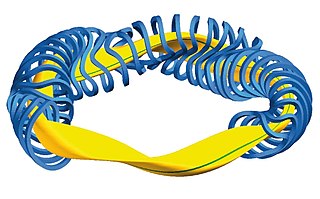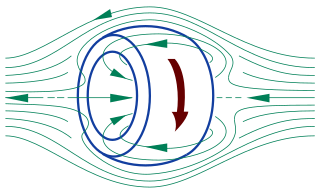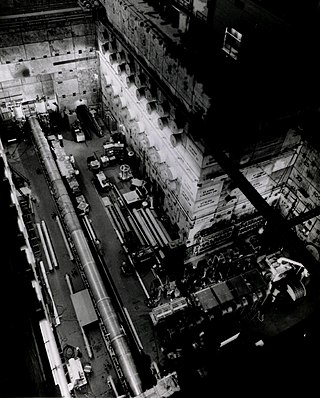Related Research Articles

A stellarator is a plasma device that relies primarily on external magnets to confine a plasma. Scientists researching magnetic confinement fusion aim to use stellarator devices as a vessel for nuclear fusion reactions. The name refers to the possibility of harnessing the power source of the stars, such as the Sun. It is one of the earliest fusion power devices, along with the z-pinch and magnetic mirror.

A tokamak is a device which uses a powerful magnetic field to confine plasma in the shape of a torus. The tokamak is one of several types of magnetic confinement devices being developed to produce controlled thermonuclear fusion power. As of 2016, it was the leading candidate for a practical fusion reactor.

Princeton Plasma Physics Laboratory (PPPL) is a United States Department of Energy national laboratory for plasma physics and nuclear fusion science. Its primary mission is research into and development of fusion as an energy source. It is known in particular for the development of the stellarator and tokamak designs, along with numerous fundamental advances in plasma physics and the exploration of many other plasma confinement concepts.

A magnetic mirror, known as a magnetic trap in Russia and briefly as a pyrotron in the US, is a type of magnetic confinement fusion device used in fusion power to trap high temperature plasma using magnetic fields. The mirror was one of the earliest major approaches to fusion power, along with the stellarator and z-pinch machines.

Fusion power is a proposed form of power generation that would generate electricity by using heat from nuclear fusion reactions. In a fusion process, two lighter atomic nuclei combine to form a heavier nucleus, while releasing energy. Devices designed to harness this energy are known as fusion reactors. Research into fusion reactors began in the 1940s, but as of 2023, no device has reached net power.
This timeline of nuclear fusion is an incomplete chronological summary of significant events in the study and use of nuclear fusion.
Thomas Howard Stix was an American physicist. Stix performed seminal work in plasma physics and wrote the first mathematical treatment of the field in 1962's The Theory of Plasma Waves.

A field-reversed configuration (FRC) is a type of plasma device studied as a means of producing nuclear fusion. It confines a plasma on closed magnetic field lines without a central penetration. In an FRC, the plasma has the form of a self-stable torus, similar to a smoke ring.
Project Sherwood was the codename for a United States program in controlled nuclear fusion during the period it was classified. After 1958, when fusion research was declassified around the world, the project was reorganized as a separate division within the United States Atomic Energy Commission (AEC) and lost its codename.

ZETA, short for Zero Energy Thermonuclear Assembly, was a major experiment in the early history of fusion power research. Based on the pinch plasma confinement technique, and built at the Atomic Energy Research Establishment in the United Kingdom, ZETA was larger and more powerful than any fusion machine in the world at that time. Its goal was to produce large numbers of fusion reactions, although it was not large enough to produce net energy.
Robert L. Hirsch is an American physicist who has been involved in energy issues from the late 1960s. Through the 1970s he directed the U.S. fusion energy program at a variety of government positions as responsibility for the project moved from the Atomic Energy Commission to the Energy Research and Development Administration and finally to the Department of Energy. After that time he was a senior energy program adviser for Science Applications International Corporation and is a Senior Energy Advisor at MISI and a consultant in energy, technology, and management.

Amasa Stone Bishop was an American nuclear physicist specializing in fusion physics. He received his B.S. in physics from the California Institute of Technology in 1943. From 1943 to 1946 he was a member of the staff of Radiation Laboratory at the Massachusetts Institute of Technology, where he was involved with radar research and development. Later, he became a staff member of the University of California at Berkeley from 1946 to 1950. Specializing in high energy particle work, he earned his Ph.D. in physics in 1950.
Sceptre was a series of early fusion power devices based on the Z-pinch concept of plasma confinement, built in the UK starting in 1956. They were the ultimate versions of a series of devices tracing their history to the original pinch machines, built at Imperial College London by Cousins and Ware in 1947. When the UK's fusion work was classified in 1950, Ware's team was moved to the Associated Electrical Industries (AEI) labs at Aldermaston. The team worked on the problems associated with using metal tubes with high voltages, in support of the efforts at Harwell. When Harwell's ZETA machine apparently produced fusion, AEI quickly built a smaller machine, Sceptre, to test their results. Sceptre also produced neutrons, apparently confirming the ZETA experiment. It was later found that the neutrons were spurious, and UK work on Z-pinch ended in the early 1960s.

The Astron is a type of fusion power device pioneered by Nicholas Christofilos and built at the Lawrence Livermore National Laboratory during the 1960s and 70s. Astron used a unique confinement system that avoided several of the problems found in contemporary designs like the stellarator and magnetic mirror. Development was greatly slowed by a series of changes to the design that were made with limited oversight, leading to a review committee being set up to oversee further development. The Astron was unable to meet the performance goals set for it by the committee; funding was cancelled in 1972 and development wound down in 1973. Work on similar designs appears to have demonstrated a theoretical problem in the very design that suggests it could never be used for practical generation.
Fusion ignition is the point at which a nuclear fusion reaction becomes self-sustaining. This occurs when the energy being given off by the reaction heats the fuel mass more rapidly than it cools. In other words, fusion ignition is the point at which the increasing self-heating of the nuclear fusion removes the need for external heating. This is quantified by the Lawson criterion. Ignition can also be defined by the fusion energy gain factor.

Stephen O. Dean is an American physicist, engineer and author. He was born in Niagara Falls, New York, United States, and grew up there through high school.
The history of nuclear fusion began early in the 20th century as an inquiry into how stars powered themselves and expanded to incorporate a broad inquiry into the nature of matter and energy, as potential applications expanded to include warfare, energy production and rocket propulsion.

Theta-pinch, or θ-pinch, is a type of fusion power reactor design. The name refers to the configuration of currents used to confine the plasma fuel in the reactor, arranged to run around a cylinder in the direction normally denoted as theta in polar coordinate diagrams. The name was chosen to differentiate it from machines based on the pinch effect that arranged their currents running down the centre of the cylinder; these became known as z-pinch machines, referring to the Z-axis in cartesian coordinates.
Harold Ralph Lewis, Jr., was an American physicist, researcher at the Los Alamos National Laboratory, and professor at Dartmouth College. Lewis worked on Project Sherwood and conducted research in nuclear physics and plasma physics.
The toroidal solenoid was an early 1946 design for a fusion power device designed by George Paget Thomson and Moses Blackman of Imperial College London. It proposed to confine a deuterium fuel plasma to a toroidal (donut-shaped) chamber using magnets, and then heating it to fusion temperatures using radio frequency energy in the fashion of a microwave oven. It is notable for being the first such design to be patented, filing a secret patent on 8 May 1946 and receiving it in 1948.
References
- ↑ Bishop, Amasa. Project Sherwood; The U.S. Program in Controlled Fusion. p. 75. ISBN 9780548389706.
- ↑ "Project Sherwood and the origin of the annual Sherwood Fusion Theory Conference" . Retrieved 20 April 2017.
- ↑ Bishop, Amasa (1958). Project Sherwood; the U.S. Program in Controlled Fusion. p. 76. ISBN 9780548389706.
- ↑ Clery, Daniel (2014). A Piece of the Sun: The Quest for Fusion Energy. The Overlook Press. ISBN 978-1468308891.
- ↑ Bishop, Amasa (1958). Project Sherwood; The U.S. Program in Controlled Fusion . Addison-Wesley Publishing Company, Inc. p. 76. ISBN 9780548389706.